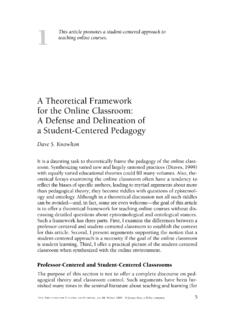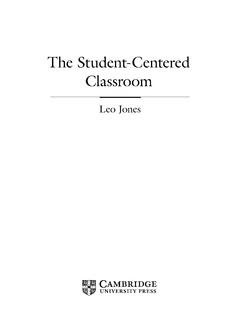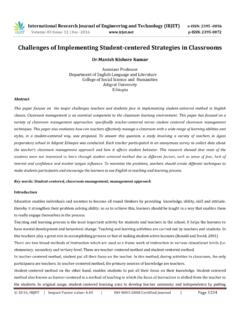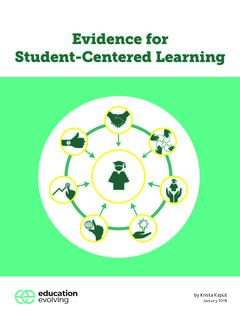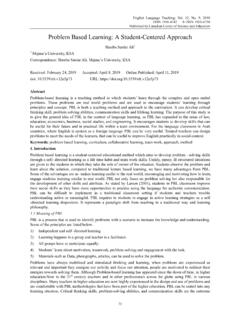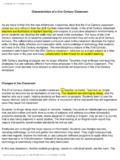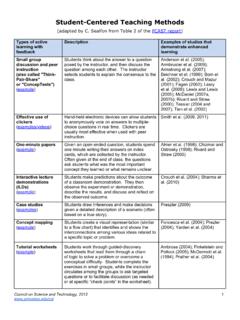Transcription of ADVANTAGES AND DISADVANTAGES OF STUDENT …
1 Research Journal of English Language and Literature (RJELAL) A Peer Reviewed (Refereed) International Journal Impact Factor (ICI) ; ISSN:2395-2636 (P); 2321-3108(O) S1. 2020 (February) 132 Proceedings of National Seminar on Proceedings of One Day National Seminar on "LEARNER CENTRED APPROACHES AND EFFECTIVE CLASS ROOM MANAGEMENT on 29th February, 2020, organized By Dept of English, VSR & NVR College (A), Tenali. ADVANTAGES AND DISADVANTAGES OF STUDENT centered learning N KUTUMBA RAO Lecturer in English GVSM Govt. Degree college, Ulavapadu, Prakasam Dist What is Learner centered Teaching (LCT) or STUDENT centered Teaching (SCT)? Learner centered Teaching is an approach that places the Learner or the students at the centre of the learning .
2 This means that the learner or STUDENT is responsible for learning while the Teacher is responsible for facilitating the learning . This is also known as STUDENT centered learning . Learner- centered education broadly encompasses methods of teaching that shift the focus of instruction from the teacher to the STUDENT . In original usage, STUDENT - centered learning aims to develop learner autonomy and independence by putting responsibility for the learning path in the hands of students by imparting them with skills and basis on how to learn a specific subject and skills required to measure up to the specific performance requirement. STUDENT centered instruction focuses on skills and practices that enable lifelong learning and independent problem solving.
3 STUDENT centered learning theory and practice are based on the constructivist learning theory that emphasizes the learner's critical role in constructing meaning from new information and prior experience. STUDENT - centered learning puts students ' interests first, acknowledging STUDENT voice as central to the learning experience. In a STUDENT - centered learning space, students choose what they will learn, how they will pace their learning , and how they will assess their own learning . This is in contrast to traditional education, also known as "Teacher centered learning ", which situates the teacher as the primarily "active" role while students take a more "passive", receptive role.
4 In a teacher- centered classroom , teachers choose what the students will learn, how the students will learn, and how the students will be assessed on their learning . In contrast, STUDENT - centered learning requires students to be active, responsible participants in their own learning and with their own pace of learning . Usage of the term " STUDENT - centered learning " may also simply refer to educational mindsets or instructional methods that recognize individual differences in learners. In this sense, STUDENT - centered learning emphasizes each STUDENT 's interests, abilities, and learning styles, placing the teacher as a facilitator of learning for individuals rather than for the class as a whole.
5 ADVANTAGES and DISADVANTAGES of STUDENT centered learning ADVANTAGES STUDENT - centered learning has ADVANTAGES for both students and Teachers. students develop learning and other skills and gain meaningful knowledge that will help them throughout life. The relationship between rights and responsibilities is learned. students discover that learning is interesting and fun. Several have written in their course evaluations that they learned more because they were involved and fun also being involved. Teachers have less traditional work to do, especially in the upper level classes during the latter portion of the academic term. students are more attentive and willing to participate in the class.
6 Complaints about irrelevant and unfairness decrease. Reports and papers generated by students increase a teacher's collection of useful information. Teacher evaluations do not decline and usually improve especially in upper level courses and teaching is interesting and fun. Many researches show that STUDENT - centered learning is effective for every member of the classroom , because it takes into account their diverse learning needs and greatly increases their retention of both knowledge and skills. Moreover, it Research Journal of English Language and Literature (RJELAL) A Peer Reviewed (Refereed) International Journal Impact Factor (ICI) ; ISSN:2395-2636 (P); 2321-3108(O) S1.
7 2020 (February) 133 Proceedings of National Seminar on Proceedings of One Day National Seminar on "LEARNER CENTRED APPROACHES AND EFFECTIVE CLASS ROOM MANAGEMENT on 29th February, 2020, organized By Dept of English, VSR & NVR College (A), Tenali. emphasizes that learning requires active engagement by the students , so it works to engage students in gain confidence in themselves as they take on new responsibilities. STUDENT - centered learning enables students to develop the necessary workplace skills. It encourages innovation and creativity through deep learning and requires students to think about their learning , and about the issues and the problems.
8 The STUDENT learns to be responsible for his own learning and actions. The STUDENT learns about things and likes working with others, team building, developing skills and how to be independent. I think that one of the most ADVANTAGES of STUDENT - centered learning is that it can be considered as a step forward to make the educational process efficient when it is applied. Through this strategy the STUDENT is no longer passive because he/she would be the core of the teaching and learning process in the classroom . Through the teacher centered system, the child was marginalized because the teacher was responsible for everything including explaining the material, engaging the students in the discussion and preparing the material.
9 This kind of learning creates an atmosphere in which the STUDENT doesn't feel interested in the subject. However, with this new methodology students feel that they are very much engaged in the discussion. They also feel that they have the opportunity to express their ideas and to participate in the material being discussed. The STUDENT centered learning creates a kind of cooperative spirit among students because they almost participate in all activities that take place in the classroom and they work together. The other one of the most important ADVANTAGES of the STUDENT - centered learning is that it gives the chance for the students to operate, manage and monitor his own learning process under the supervision and the guidance of the teacher, so that he could train his self to be independent and this qualifies him to be a good future leader.
10 Another important advantage of the STUDENT - centered learning is that it stimulates students to initiate and monitor their own learning rather than depending on their teacher. It is clear that the students are encouraged to be active and pursuance of the knowledge by themselves. This, I do believe, the upcoming generations of students will not need others to guide them or to tell them what they have to do. students have a control in the classroom . They are given more freedom to learn at their own pace and to review with no material left behind. students get to feel confident without having to worry if everyone in the classroom gets the material but they do not. students have hoped that they will pass with their own knowledge.

